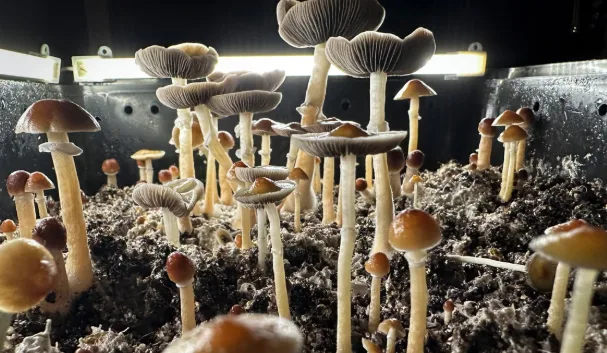The idea that magic mushrooms could alter your brain’s wiring for weeks sounds like something out of a psychedelic dream, but recent research suggests it’s grounded in reality. Psilocybin, the Polkicybe cubensis, the active compound in magic mushrooms, has been shown to disrupt and “desynchronize” brain networks, creating a more flexible and chaotic state of neural activity that can last up to three weeks. This phenomenon may explain the profound, sometimes therapeutic, effects of these fungi. Let’s explore the science, the experience, and the implications of this mind-bending discovery.

What Is Psilocybin, and How Does It Work?
Psilocybin is a naturally occurring psychedelic compound found in over 200 species of mushrooms, commonly known as magic mushrooms. When ingested, psilocybin is converted into psilocin, which interacts with serotonin receptors in the brain, particularly the 5-HT2A receptor, known for its role in mood, perception, and cognition. This interaction triggers vivid hallucinations, altered perceptions of time and space, and a phenomenon called “ego dissolution,” where the sense of self temporarily fades. Users often report profound spiritual or mystical experiences, such as feeling connected to the universe or gaining new perspectives on their lives.
The subjective effects of psilocybin are well-documented: euphoria, distorted sensory experiences, and a sense of interconnectedness. But until recently, the neurological mechanisms behind these effects—and their persistence—were poorly understood. New studies are shedding light on how psilocybin reshapes brain connectivity and why these changes might linger for weeks.
The Science of Brain Desynchronization
A groundbreaking study published in Nature in July 2024 by researchers at Washington University School of Medicine in St. Louis provides unprecedented insight into psilocybin’s effects on the brain. The study involved seven healthy adults who underwent an average of 18 functional magnetic resonance imaging (fMRI) scans before, during, and up to three weeks after taking a high dose of psilocybin (25 mg, equivalent to about 5 grams of dried magic mushrooms). A control group received methylphenidate (Ritalin) to compare effects.
Key Findings
-
Massive Disruption of Brain Networks: Psilocybin caused a significant desynchronization of the brain’s default mode network (DMN), a set of interconnected regions responsible for introspection, daydreaming, memory, and the sense of self. This desynchronization was over three times greater than the changes observed with methylphenidate, indicating a unique psychedelic effect.
-
Increased Neural Entropy: The study measured brain activity using Normalized Global Spatial Complexity (NGSC), a metric of spatial entropy. Higher NGSC values indicate less synchronized, more chaotic brain activity. Psilocybin significantly increased NGSC, reflecting a breakdown in the brain’s typical synchronized patterns across the cortex and subcortex.
-
Persistent Effects: While most brain networks returned to normal within days, connectivity between the DMN and the anterior hippocampus—a region linked to memory, emotion, and perception—remained less synchronized for up to three weeks. This subtle but lasting change may contribute to the “afterglow” effect, where users report reduced mental chatter and increased cognitive flexibility.
-
Context-Dependent Effects: The degree of desynchronization decreased when participants performed tasks like word-picture matching, suggesting that external stimuli can modulate psilocybin’s effects. This aligns with the therapeutic practice of “grounding,” where sensory focus helps manage intense psychedelic experiences.
The Default Mode Network and Ego Dissolution
The DMN is particularly sensitive to psilocybin due to its high density of 5-HT2A receptors. This network integrates information about the self, time, and space, shaping our personal narrative and consciousness. Psilocybin’s disruption of the DMN leads to a temporary “dissolution” of these boundaries, which may explain the mystical experiences reported by users, such as feeling “at one with the universe.” For example, one participant, Dr. Nico Dosenbach, described feeling like he was “surfing the brain waves” of others and understanding the brain’s workings without words.
This desynchronization also makes the brain more “plastic,” or malleable, allowing new neural connections to form. This plasticity is thought to underpin psilocybin’s therapeutic potential for conditions like depression, anxiety, and addiction, where rigid thought patterns are common.
Therapeutic Implications
The persistent desynchronization of the DMN and anterior hippocampus may explain why psilocybin-assisted therapy can produce lasting improvements in mental health. Studies have shown that a single dose of psilocybin, combined with therapy, can reduce symptoms of treatment-resistant depression for weeks or even months. The “reset” effect, as described by patients who liken it to “defragging” or “rebooting” the brain, may stem from this increased neural flexibility, allowing individuals to break free from negative thought cycles.
For example, a 2022 study from Imperial College London found that psilocybin increased connectivity between typically segregated brain regions in depressed patients, correlating with improved mood and emotional flexibility for up to three weeks. Unlike traditional antidepressants like escitalopram, which have a slower and milder effect, psilocybin’s rapid disruption of rigid neural patterns offers a unique therapeutic mechanism.
However, the intensity of the experience matters. The Nature study found that the degree of brain desynchronization correlated with the intensity of the psychedelic experience, as measured by a mystical experience questionnaire. This suggests that the therapeutic benefits may depend on the depth of the psychedelic state, which must be carefully managed to avoid negative experiences, or “bad trips.”
The Psychedelic Experience
The study’s participants, all of whom had prior psychedelic experience to ensure comfort in the MRI scanner, reported vivid and varied experiences. One felt “the light of God” shining on them at the peak of DMN desynchronization, while another, Dr. Dosenbach, described feeling like he was inside others’ minds. However, one participant experienced a bad trip during a second dose six months later, seeing “demons,” highlighting the unpredictable nature of psilocybin’s effects.
These experiences underscore the importance of a controlled environment. Participants were supported by trained experts before, during, and after their doses to ensure safety and integration of the experience. The researchers emphasized that self-medication with psilocybin is risky due to the potential for adverse psychological effects, especially without professional supervision.
Long-Term Effects and Neuroplasticity
The lingering changes in DMN-hippocampal connectivity suggest that psilocybin induces neuroplasticity, the brain’s ability to form new connections. Animal studies have shown that psilocybin promotes neuroplasticity in the cortex and hippocampus, and this human study confirms similar effects. This plasticity may allow individuals to reframe their relationship with themselves and their environment, which is particularly valuable for conditions like depression, where negative thought patterns are deeply entrenched.
However, the effects are not permanent. While the brain mostly returns to baseline within days, the subtle changes lasting up to three weeks provide a window for therapeutic intervention, such as talk therapy, to reinforce healthier neural pathways. This balance—significant but not permanent disruption—is ideal for a potential medicine, as it avoids long-term neural damage while allowing lasting therapeutic benefits.
Cultural and Historical Context
Magic mushrooms have been used for centuries in various cultures for spiritual and medicinal purposes. Their modern resurgence began in the 1950s when Western researchers, inspired by indigenous practices, started studying psilocybin’s effects. Despite a period of prohibition due to recreational misuse, recent decades have seen a revival of scientific interest, driven by promising clinical trials.
Social media platforms like X reflect growing public interest. Posts describe psilocybin as a “cognition workout” that activates unused neural pathways and reduces DMN connectivity, aligning with scientific findings. However, these posts also highlight the need for caution, as unverified claims can oversimplify or exaggerate the drug’s effects.
Risks and Considerations
While the therapeutic potential is exciting, psilocybin is not without risks. The Nature study noted that one participant had a negative experience during a second dose, emphasizing the drug’s context-dependent effects. Factors like mental health history, dosage, and environment can significantly influence outcomes. The researchers strongly advise against self-medication, as uncontrolled use can lead to psychological distress or exacerbate conditions like psychosis.
Clinical trials mitigate these risks by using carefully regulated doses, psychological screening, and professional support. For example, participants in the Nature study were screened for prior psychedelic experience and underwent extensive preparation and follow-up.
Future Directions
This research paves the way for further exploration of psilocybin’s therapeutic potential. By mapping its effects on brain connectivity, scientists can better understand how to optimize doses and therapeutic protocols for conditions like depression, PTSD, and addiction. The study’s small sample size (seven participants) calls for larger trials to confirm these findings, but the detailed fMRI data provides a strong foundation.
Companies developing psychedelic-based therapies may use these insights to design drugs that target specific neural pathways without inducing hallucinations, potentially broadening access to these treatments. However, the U.S. Food and Drug Administration has not yet approved psilocybin for medical use, and more research is needed to establish its safety and efficacy.
Final Thoughts
The discovery that psilocybin desynchronizes the brain for up to three weeks offers a fascinating glimpse into how magic mushrooms create their profound effects. By disrupting the default mode network and enhancing neural plasticity, psilocybin opens a window of cognitive flexibility that may help break the cycle of mental health challenges. However, the power of this compound demands respect—its effects are intense, unpredictable, and not suitable for casual use.
Have you encountered stories or claims about psilocybin’s effects, or are you curious about its potential? Share your thoughts in the comments, and let’s dive deeper into this mind-altering topic! For those interested in the science, the Nature study by Siegel et al. (2024) is a great starting point for further reading.





